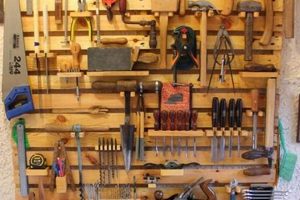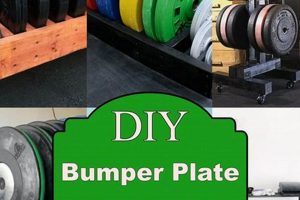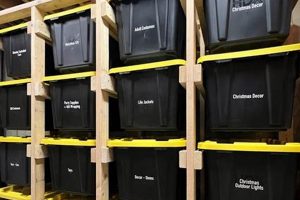Constructing customized organizational furniture offers individuals a method for creating storage solutions tailored to specific spatial constraints and aesthetic preferences. This approach involves utilizing readily available materials and fundamental tools to fabricate shelving units, thereby providing accessible and personalized storage options. These structures can range from simple wall-mounted units to more elaborate freestanding systems.
The advantages of this hands-on approach extend beyond mere utility. It presents an opportunity to optimize space efficiently, reduce reliance on mass-produced items, and foster a sense of accomplishment. Historically, resourcefulness in home organization has been a necessity, particularly during periods of economic constraint. Today, it continues to be valued for its potential to conserve resources and express individual creativity.
The subsequent discussion will delve into key aspects of this topic, encompassing material selection, design considerations, and essential construction techniques. A focus will be placed on providing practical guidance for individuals seeking to implement their own organizational furniture projects, regardless of prior experience.
Guidance on Constructing Customized Shelving Units
The following recommendations aim to provide actionable advice for individuals embarking on the construction of customized organizational shelving. These suggestions address critical elements of the planning and execution phases.
Tip 1: Conduct Thorough Spatial Assessment: Prior to initiating construction, meticulously measure the intended location. Account for potential obstructions, such as pipes or electrical outlets, and incorporate these factors into the design. Accurate measurements are crucial for ensuring a proper fit.
Tip 2: Prioritize Material Selection Based on Load Capacity: Choose materials commensurate with the anticipated weight load. Solid wood or reinforced plywood are generally suitable for heavier items, while lighter materials may suffice for lighter loads. Verify the load-bearing capacity of chosen materials to prevent structural failure.
Tip 3: Employ Precise Cutting Techniques: Accurate cuts are fundamental to achieving a professional finish and structural integrity. Utilize appropriate cutting tools, such as a circular saw or miter saw, and ensure proper blade selection. Practice on scrap material to refine technique and minimize errors.
Tip 4: Secure Fastening Methods: Employ robust fastening methods, such as screws or bolts, to securely join components. Consider the material type and load requirements when selecting fasteners. Pre-drilling pilot holes is recommended to prevent splitting or cracking, particularly when working with wood.
Tip 5: Ensure Level Installation: Verify that the shelving unit is level during installation. Utilize a spirit level or laser level to ensure accurate alignment. Shims can be used to compensate for uneven surfaces and maintain stability.
Tip 6: Apply Appropriate Finishes: Consider applying a protective finish to enhance durability and aesthetic appeal. Options include paint, stain, or sealant. Properly prepare the surface prior to applying the finish to ensure optimal adhesion and longevity.
Tip 7: Prioritize Safety Precautions: Always wear appropriate safety equipment, including eye protection and respiratory protection, when cutting, sanding, or applying finishes. Work in a well-ventilated area and adhere to manufacturer’s instructions for all tools and materials.
Adherence to these guidelines will contribute to the creation of functional, durable, and aesthetically pleasing customized shelving units. Diligent planning and careful execution are essential for successful project completion.
The subsequent section will explore specific design considerations applicable to various organizational contexts.
1. Material Durability
Material durability represents a critical factor in the design and construction of organizational furniture. The selection of appropriate materials directly influences the lifespan, load-bearing capacity, and overall suitability of shelving units for their intended purpose. Inferior material choices can lead to premature failure, rendering the shelving ineffective and potentially hazardous.
- Wood Species Selection
The choice of wood species significantly impacts the durability of wooden shelving. Hardwoods, such as oak and maple, offer superior resistance to wear and tear compared to softwoods like pine. Hardwoods are more appropriate for shelving intended to support heavy loads or withstand frequent use. The increased density and inherent strength of hardwoods contribute to a longer lifespan and reduced susceptibility to damage.
- Plywood Grade and Composition
For shelving constructed from plywood, the grade and composition are paramount. Higher grades of plywood, such as cabinet-grade plywood, exhibit fewer voids and a more consistent veneer construction, resulting in greater strength and stability. The adhesive used in bonding the layers of plywood also influences durability; exterior-grade adhesives provide enhanced resistance to moisture and delamination, extending the lifespan of the shelving in humid environments.
- Metal Gauge and Coating
In metal shelving applications, the gauge of the metal determines its load-bearing capacity and resistance to deformation. Thicker gauge metals offer greater strength and stability. Furthermore, the application of protective coatings, such as powder coating or galvanization, enhances resistance to corrosion and environmental degradation, prolonging the lifespan of the shelving, particularly in areas prone to humidity or exposure to chemicals.
- Plastic Composition and UV Resistance
The composition of plastics used in shelving impacts their durability. High-density polyethylene (HDPE) and polypropylene (PP) offer increased strength and resistance to impact compared to lower-density plastics. Additionally, UV resistance is crucial for shelving exposed to direct sunlight, as prolonged exposure can cause degradation and embrittlement, leading to premature failure. UV-resistant additives can mitigate this effect, extending the lifespan of plastic shelving in outdoor or brightly lit environments.
The selection of appropriate materials, considering factors such as wood species, plywood grade, metal gauge, and plastic composition, is essential for ensuring the durability and longevity of organizational furniture. A thorough understanding of material properties and their suitability for specific applications is crucial for creating functional and reliable storage solutions. Failure to prioritize material durability can result in increased maintenance costs, premature replacement, and potential safety hazards.
2. Structural Integrity
Structural integrity, in the context of constructed organizational furniture, denotes the capacity of the shelving unit to withstand anticipated loads and environmental stresses without deformation, collapse, or other forms of failure. It is a fundamental consideration in the design and construction of any load-bearing structure, including shelving units fabricated through do-it-yourself methods. A lack of structural integrity can lead to property damage, personal injury, or the ineffectiveness of the storage solution.
- Load Distribution and Support Systems
Effective load distribution is paramount to structural integrity. Proper spacing of vertical supports, such as uprights or legs, ensures that the weight is evenly distributed across the shelving unit, preventing localized stress concentrations that could lead to failure. The design of the support system, including the use of braces or gussets, further enhances the ability of the structure to withstand vertical and lateral forces. Examples include reinforcing shelves with metal brackets to support heavy books or adding cross-bracing to a freestanding unit to prevent swaying. Failure to adequately address load distribution can result in sagging shelves, instability, and eventual collapse.
- Material Selection and Fastener Strength
The choice of materials directly impacts structural integrity. Selecting materials with sufficient strength and stiffness for the intended load is crucial. Solid wood, high-density plywood, and steel offer varying degrees of strength and durability. The type and spacing of fasteners, such as screws, nails, or bolts, also play a critical role. Insufficient fastener strength or improper installation can compromise the connections between structural components, leading to weakness and potential failure. For example, using drywall screws in a load-bearing application or failing to pre-drill pilot holes in hardwood can significantly reduce the holding power of the fasteners.
- Joint Design and Construction Techniques
The design and execution of joints between structural components significantly affect the overall strength and stability of the shelving unit. Strong and well-fitted joints, such as mortise and tenon, dovetail, or rabbet joints, provide superior resistance to shear and tensile forces compared to simple butt joints. Proper use of adhesives, such as wood glue or epoxy, further strengthens the joints. Failure to employ appropriate joint construction techniques can lead to weakened connections and reduced load-bearing capacity. A common example is constructing shelves with butt joints held together only by nails, which are prone to separating under stress.
- Dimensional Stability and Environmental Considerations
Dimensional stability refers to the ability of a material to maintain its shape and size under varying environmental conditions, particularly temperature and humidity. Wood, for instance, is susceptible to expansion and contraction with changes in moisture content, which can stress joints and compromise structural integrity. Proper sealing or finishing of wood surfaces can help mitigate moisture absorption and reduce dimensional instability. In environments with high humidity or temperature fluctuations, selecting materials resistant to these effects is essential for maintaining the long-term structural integrity of the shelving unit.
The multifaceted nature of structural integrity necessitates careful attention to design, material selection, and construction techniques. Neglecting any of these aspects can compromise the stability and safety of the shelving unit. When constructing organizational furniture, prioritizing structural integrity ensures a durable, reliable, and safe storage solution.
3. Spatial Optimization
Spatial optimization, in the context of customized organizational furniture, pertains to the efficient and effective utilization of available space to maximize storage capacity and minimize spatial intrusion. The construction of shelving units directly facilitates spatial optimization by allowing for the creation of storage solutions tailored to specific dimensional constraints and user needs. A key benefit lies in the ability to design shelving that conforms precisely to available alcoves, corners, or wall spaces, thereby minimizing wasted volume. For instance, in a small apartment with limited closet space, a custom-built shelving unit designed to fit the dimensions of a particular wall can significantly increase storage capacity without encroaching excessively on the living area. This represents a targeted solution, diverging from the limitations of mass-produced shelving units with fixed dimensions.
Furthermore, spatial optimization through shelving extends beyond mere dimensional fitting. It involves the strategic placement and configuration of shelves to accommodate specific items. Adjustable shelving systems, for example, allow users to reconfigure shelf heights to accommodate items of varying sizes, minimizing unused vertical space. The incorporation of specialized storage elements, such as drawers, bins, or hanging rods, further enhances spatial efficiency by providing dedicated storage solutions for different types of items. A workshop, for example, could benefit from a customized shelving unit with adjustable shelves for storing tools of different sizes, drawers for storing small parts, and a pegboard for hanging frequently used items. Such a configuration optimizes the workspace by ensuring that all items are readily accessible and efficiently stored.
In conclusion, spatial optimization represents a central benefit of creating customized shelving. It addresses the inherent limitations of standardized storage solutions by enabling the fabrication of shelving units tailored to specific spatial parameters and user needs. Challenges associated with spatial optimization include accurate measurement, careful planning, and the selection of appropriate materials and construction techniques. However, the potential benefits, in terms of increased storage capacity and improved spatial efficiency, make spatial optimization a critical consideration in the design and construction of shelving units.
4. Design Aesthetics
Design aesthetics significantly influence the perceived value and integration of customized organizational furniture within a given environment. While functionality remains paramount, the visual appeal of shelving units contributes to the overall ambiance and user satisfaction. The selection of materials, finishes, and structural forms dictates the aesthetic impact of the shelving, impacting its compatibility with existing decor and architectural styles. For instance, shelving constructed from reclaimed wood with visible grain patterns can impart a rustic charm to a space, while sleek, minimalist designs utilizing metal and glass align with contemporary aesthetics. The aesthetic component, therefore, transforms a purely utilitarian object into a contributing element of interior design.
Considerations surrounding design aesthetics extend beyond mere surface appearance. The proportion and scale of the shelving in relation to the surrounding space exert a strong influence on visual harmony. Oversized shelving in a small room can appear visually overwhelming, while undersized shelving in a large room may seem insignificant. Furthermore, the arrangement and display of items on the shelves contribute to the overall aesthetic effect. Cluttered, disorganized shelving can detract from the visual appeal of a space, while carefully curated displays of books, artwork, or decorative objects can enhance the aesthetic value of the shelving unit and the surrounding environment. The thoughtful integration of lighting, such as strategically placed spotlights or integrated LED strips, can further accentuate the aesthetic qualities of the shelving and its contents.
In conclusion, the integration of design aesthetics into the construction of customized organizational furniture elevates the shelving unit from a mere storage solution to a contributing element of interior design. The selection of materials, finishes, structural forms, and the careful arrangement of items on the shelves all contribute to the overall aesthetic impact. Prioritizing design aesthetics, alongside functionality and structural integrity, ensures that the shelving unit not only fulfills its practical purpose but also enhances the visual appeal and ambiance of the space it occupies.
5. Cost Efficiency
The pursuit of cost efficiency serves as a primary motivator for individuals undertaking do-it-yourself storage shelf projects. A significant reduction in expenditure, compared to purchasing pre-fabricated units, often results from leveraging readily available materials and minimizing labor costs. The cost differential is particularly pronounced when comparing custom-sized or uniquely designed shelving units with their commercially produced counterparts. For example, a homeowner requiring shelving to fit an irregularly shaped closet may find that constructing a custom unit using lumber purchased directly from a building supply store is substantially less expensive than commissioning a comparable unit from a furniture manufacturer. This difference stems from eliminating retail markups and fabrication labor costs.
Material selection significantly influences the overall cost efficiency of a DIY project. Repurposing reclaimed wood or utilizing less expensive grades of lumber can further reduce expenses. However, a careful assessment of material durability and load-bearing capacity remains crucial to avoid compromising structural integrity and incurring future repair or replacement costs. A prudent approach involves balancing initial cost savings with long-term performance. A common example is the use of plywood over solid hardwood for shelving in a garage. While plywood is typically less expensive, reinforcing it adequately is necessary to support heavier items, potentially adding to the overall project cost. The decision, therefore, requires a cost-benefit analysis considering both the material cost and the intended use of the shelving.
In summary, cost efficiency constitutes a key advantage of creating organizational shelving independently. While the initial investment in materials and tools is necessary, the potential for significant cost savings compared to retail purchases, particularly for custom-designed units, renders DIY projects an attractive option. The optimal approach involves a holistic assessment of material costs, labor requirements, and long-term durability to ensure a balance between economic considerations and functional performance. Challenges may arise in accurately estimating material quantities and accounting for unforeseen expenses. Nevertheless, the potential for cost savings remains a compelling driver for individuals considering creating their own storage solutions.
6. Ease Assembly
Ease of assembly constitutes a critical factor determining the accessibility and appeal of do-it-yourself organizational shelving projects. The complexity of construction directly influences the time investment, skill level required, and potential for successful completion. A design characterized by simplified assembly procedures broadens the user base, allowing individuals with limited carpentry experience to create functional storage solutions. Conversely, intricate designs necessitating specialized tools or advanced techniques can deter prospective constructors and lead to project abandonment. A common example is the comparison between shelving units utilizing pre-cut boards and interlocking joinery versus those requiring precise measurements, complex cuts, and intricate fastening methods. The former presents a significantly lower barrier to entry, promoting wider adoption.
Simplified assembly procedures translate into several practical advantages. Reduced construction time allows for quicker deployment of storage solutions, addressing immediate organizational needs. Minimized skill requirements empower individuals with limited experience, fostering self-sufficiency and reducing reliance on external assistance. Lower complexity also reduces the likelihood of errors during construction, leading to a more structurally sound and aesthetically pleasing finished product. Consider the impact of modular shelving systems designed for tool-free assembly. These systems, often employing snap-fit or cam-lock mechanisms, enable rapid construction and reconfiguration, catering to individuals with minimal time or technical expertise. The resulting efficiency and flexibility enhance the overall value proposition of the DIY approach.
In conclusion, ease of assembly serves as a cornerstone of accessible and successful do-it-yourself shelving projects. Simplifying construction processes and minimizing technical requirements expands the potential user base and increases the likelihood of project completion. While more complex designs may offer greater customization or aesthetic sophistication, prioritizing ease of assembly remains a vital consideration for maximizing the appeal and practicality of DIY organizational shelving. Overlooking this aspect can inadvertently limit the accessibility and adoption of otherwise valuable storage solutions.
Frequently Asked Questions
The following addresses commonly encountered inquiries concerning the creation of customized storage solutions through self-directed construction methods.
Question 1: What are the primary factors to consider when selecting materials for self-built shelving?
Material selection should prioritize load-bearing capacity, environmental resistance, and aesthetic compatibility. Wood species, plywood grade, metal gauge, and plastic composition are critical variables. The intended use and location of the shelving unit dictate the appropriate material choice.
Question 2: How can structural integrity be ensured in a self-constructed shelving unit?
Structural integrity hinges on effective load distribution, proper material selection, robust fastening methods, and sound joint construction techniques. Reinforcements, such as braces and gussets, can enhance stability. Compliance with established engineering principles is advised.
Question 3: What tools are essential for constructing basic shelving units?
Essential tools include a measuring tape, level, saw (circular or hand), drill with various bits, screwdriver, and safety glasses. Additional tools, such as a miter saw or sander, can enhance precision and finish quality but are not strictly required for basic construction.
Question 4: How does one accurately measure and plan for shelving in an irregular space?
Accurate measurement involves utilizing a measuring tape and level to determine the precise dimensions of the space, accounting for any irregularities. A detailed plan or sketch, incorporating all measurements and material specifications, is crucial before commencing construction. Digital modeling software can aid in visualization and planning.
Question 5: What safety precautions should be observed during the construction process?
Safety precautions include wearing appropriate eye protection, respiratory protection (when sanding or applying finishes), and gloves. Working in a well-ventilated area is essential. Familiarization with the operating instructions for all tools and adherence to manufacturer’s safety guidelines are mandatory.
Question 6: What are some common mistakes to avoid when building shelving?
Common mistakes include inadequate measurement, insufficient load-bearing capacity, improper fastening, neglecting to ensure level installation, and disregarding safety precautions. Careful planning, meticulous execution, and adherence to established construction principles mitigate these risks.
The information provided herein serves as a general guide and should not be construed as professional engineering advice. Consulting with a qualified professional is recommended for complex or high-load applications.
The subsequent section will delve into advanced techniques for enhancing the functionality and aesthetics of do-it-yourself storage shelving.
Conclusion
This exposition has explored the multifaceted aspects of self-directed construction of organizational furniture. From material selection and structural integrity to spatial optimization, design aesthetics, cost efficiency, and ease of assembly, the factors influencing the success of diy storage shelf projects have been examined. The analysis underscores the potential for individuals to create customized solutions that address specific storage needs while potentially reducing costs and fostering personal creativity.
The information presented serves as a foundation for informed decision-making. Individuals considering this approach should carefully assess their skills, resources, and the specific requirements of their storage needs. Diligent planning and execution are crucial for achieving a functional, durable, and aesthetically pleasing outcome. The creation of diy storage shelf represents a viable alternative to commercial offerings, demanding informed execution for optimal results.







